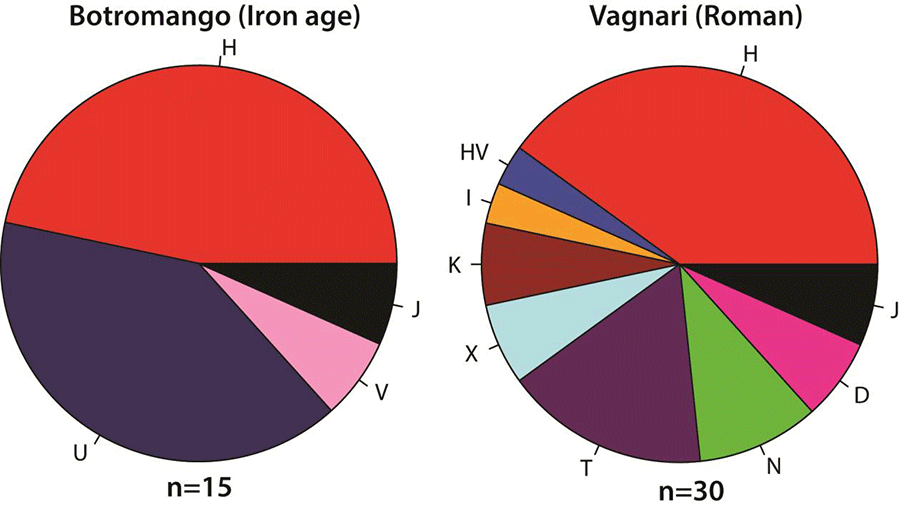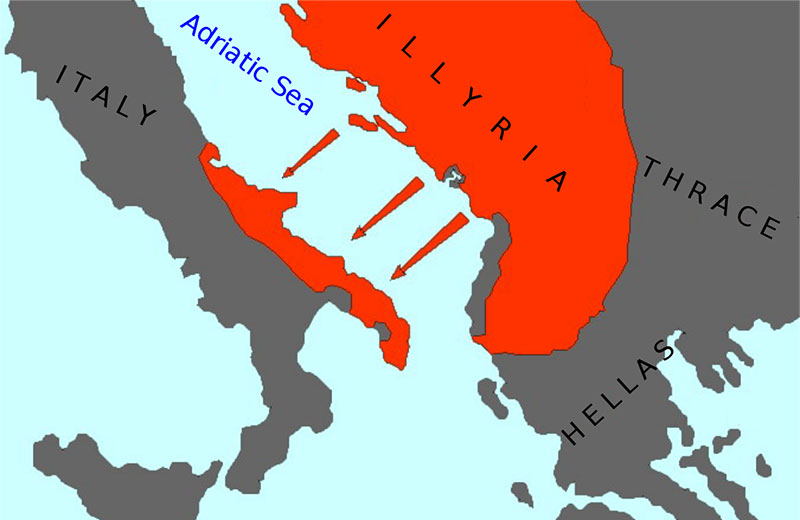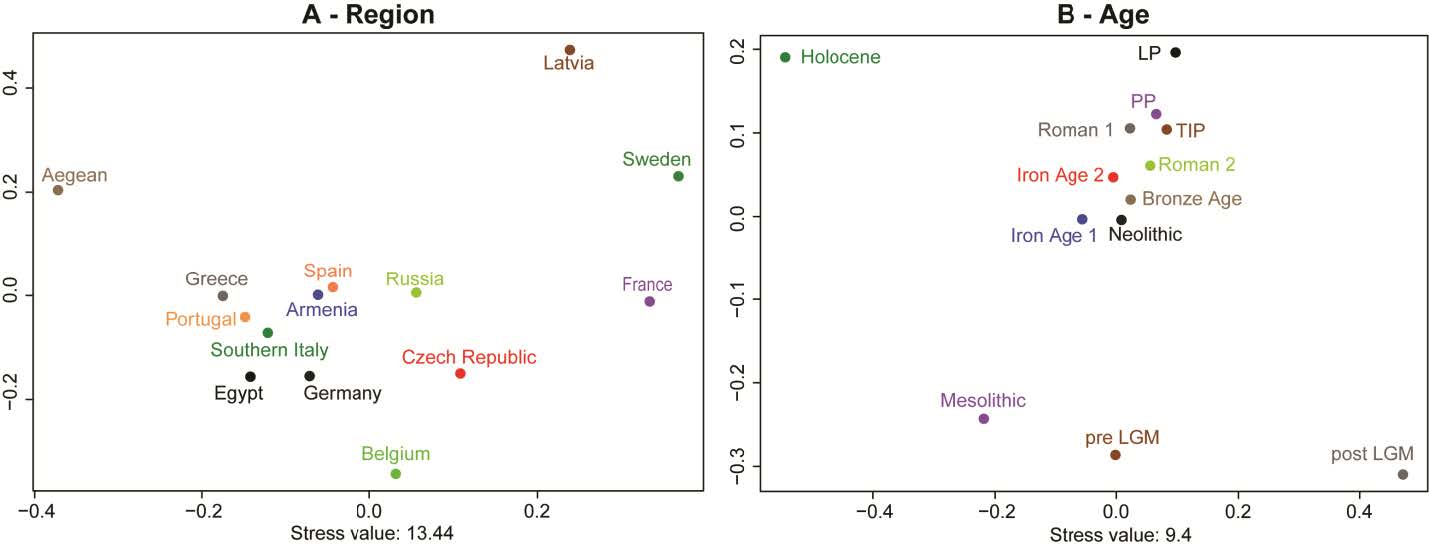Ph.D. thesis Assessing Migration and Demographic Change in pre-Roman and Roman Period Southern Italy Using Whole-Mitochondrial DNA and Stable Isotope Analysis, or The Biogeographic Origins of Iron Age Peucetians and Working-Class Romans From Southern Italy, by Matthew Emery, McMaster University (2018).
Abstract (emphasis mine):
Assessing population diversity in southern Italy has traditionally relied on archaeological and historic evidence. Although informative, these lines of evidence do not establish specific instances of within lifetime mobility, nor track population diversity over time. In order to investigate the population structure of ancient South Italy I sequenced the mitochondrial DNA (mtDNA) from 15 Iron Age (7th – 4th c. BCE) and 30 Roman period (1st – 4th c. BCE) individuals buried at Iron Age Botromagno and Roman period Vagnari, in southern Italy, and analyzed δ18O and 87Sr/86Sr values from a subset of the Vagnari skeletal assemblage.
Phylogenetic analysis of 15 Iron Age mtDNAs together with 231 mtDNAs spanning European prehistory suggest that southern Italian Iapygians share close genetic affinities to Neolithic populations from eastern Europe and the Near East. Population pairwise analysis of Iron Age, Roman, and mtDNA datasets spanning the pan-Mediterranean region (n=357), indicate that Roman maternal genetic diversity is more similar to Neolithic and Bronze Age populations from central Europe and the eastern Mediterranean, respectively, than to Iron Age Italians. Genetic distance between population age categories imply moderate mtDNA turnover and constant population size during the Roman conquest of South Italy in the 3rd century BCE.
In order to determine the local versus non-local demographic at Vagnari, I measured the 87Sr/86Sr and 18O/16O of composition of 43 molars, and the 87Sr/86Sr composition of an additional 13 molars, and constructed a preliminary 87Sr/86Sr variation map of the Italian peninsula using disparate 87Sr/86Sr datasets. The relationship between 87Sr/86Sr and previously published δ18O data suggest a relatively low proportion of migrants lived at Vagnari (7%).
This research is the first to generate whole-mitochondrial DNA sequences from Iron Age and Roman period necropoleis, and demonstrates the ability to gain valuable information from the integration of aDNA, stable isotope, archaeological and historic evidence.

Interesting excerpts:
Taken together, population pairwise ΦST, and the distribution of mtDNA haplotypes in relation to the comparative mtDNA data set show that the Iron Age southern Italians likely descended from early to late Neolithic farmers from Anatolia and possibly as far East as the Caucasus, and from migrants arriving from eastern Europe around the late Neolithic/early Bronze Age. These findings support previous hypotheses that the ancestors of the Iapygians may have originated in the eastern Balkan region, or derive shared ancestry with a common source population from eastern Europe. Alternatively, southern Italian Iron Age mtDNA variation might also reflect LGM gene flow between southwestern European, Mediterranean, and Carpathian basin refugia, which was suggested for haplogroup subclusters of U5 and J (Malyarchuk et al., 2010; Pala et al., 2012). Future mtDNA (and nuclear DNA) analysis comprised of a larger Iron Age data set from southern Italy is necessary to answer Theodor Mommsen’s initial hypothesis that the Iapygians were the oldest immigrants to the southern Italian region.
Our investigation provides the first mtDNA evidence for the maternal ancestral affiliations of a subset of the Iapygian individuals recovered from southern Italy, and suggests a closer genetic link to European Neolithic and Iron Age Armenians, than to Bronze Age Aegeans. Future comparative ancient DNA data using whole-genome SNP, mtDNA, and NRY-chromosome analysis of pre-Roman populations will provide complementary evidence for the ancestral roots of understudied Iron Age individuals from Italy.

Archaeological evidence indicates that the Iapygians traded and incorporated Hellenistic elements into their material and cultural traditions (Small, 1992; Peruzzi, 2016). These changes are most apparent in burial custom and ceramic production, and become increasingly prominent by 2400 BP (Peruzzi, 2016). Further evidence shows that Iron Age communities across South Italy retracted in size amidst ongoing conflict between colonies in Magna Graecia, and Rome and Carthage (Small, 1992). This apparent change was interpreted as a decline in local populations throughout the region. However, Bayesian Skygrid analysis using the mtDNA profiles of 15 Iapygians and 30 Roman period individuals suggest that female effective population size was comparable between the two populations. In Chapter 4, population distance (measured as population pairwise ΦST values) across a range of mtDNAs obtained from the pan-Mediterranean, European, and western Asian regions suggest closer maternal affinities to Neolithic and Bronze Age populations from the eastern Mediterranean as a cohort, than with Iron Age Italians. This finding points to moderate mtDNA turnover, and is likely the consequence of Roman gene flow stemming from central and northern Italy via the migration and subsequent occupation by Roman colonies after 2250 BP.
Roman Imperial pursuits peaked by ~2050 BP. This extension of power, coupled with an increase in food and materials procurement, was driven by a substantial labour force comprised of both low status Romans and slaves (Harris, 1980; Bradley, 1987, 1994, 2000). Although several attempts have been made to quantify the number of slaves required to maintain the Roman economy, it is unknown what fraction of the Roman population was slave-owned (~approximately 1 to 3 million by 2050 BP) (Scheidel, 2005). Rome’s slave acquisition during the early centuries of the Republic was likely maintained through military campaigns and conquest, a trend that is well documented in Italy (Scheidel, 1997, 1999, 2005; Harris, 1999; Small, 2002). However, once territory was secured, local slave populations were likely maintained through one or a combination of the following: i) the importation of slaves from non-local regions, ii) were born to slave-owned parents, or iii) were voluntarily self-enslaved to acquire subsistence (Harris, 1999). The importation of foreign slaves was likely more costly than maintaining a self-reproducing slave population, especially in rural areas. As such, rural Roman necropoleis, such Vagnari, provide an opportune case to determine the local versus non-local demographic. Archaeological evidence suggests that Vagnari was involved in agriculture and industrial procurement, and was likely staffed by low-class individuals possibly including slaves (Small et al., 2000). However, without direct archaeological or epigraphic evidence, it is impossible to identify the proportion of slaves at rural sites.

(…) The isotope values presented in Chapter 3 obtained from 56 Roman individuals buried at Vagnari suggest that over half (58%) were born directly at Vagnari, with a further 34% originating from South Italy. Only 7% (3/43 with both δ18O and 87Sr/86Sr values) of the individuals sampled resulted in isotope values non-local to the southern peninsula. Two of these individuals originated from either northern Italy or, more broadly, from central Europe, while one individual likely originated from North Africa. Overall, the isotope data suggest a low number of immigrants at Vagnari, which conforms with the population pairwise (ΦST) data for the Iron Age and Roman mtDNAs, and suggests that as the Romans occupied the region, they populated their Imperial properties with people from central Italy (possible the region of Latium, and the surrounding environs of Rome). These results also integrate with the historical evidence concerning the Roman slave economy during the Imperial period. Future research using a larger comparative dataset comprised of pre-Roman and Roman period mtDNAs, δ18O and, 87Sr/86Sr results will refine the interpretations outlined here.
A paper from this thesis is already published in a peer-review journal, Mapping the origins of Imperial Roman workers (1st–4th century CE) at Vagnari, Southern Italy, using 87Sr/86Sr and δ18O variability, Am J Phys Anthropol (2018).
Related:
- Y-DNA relevant in the postgenomic era, mtDNA study of Iron Age Italic population, and reconstructing the genetic history of Italians
- Palaeolithic and Mesolithic connections between Italy and the Balkans, and the potential expansion of the Villabruna cluster and haplogroup R1b in Europe
- Germanic tribes during the Barbarian migrations show mainly R1b, also I lineages